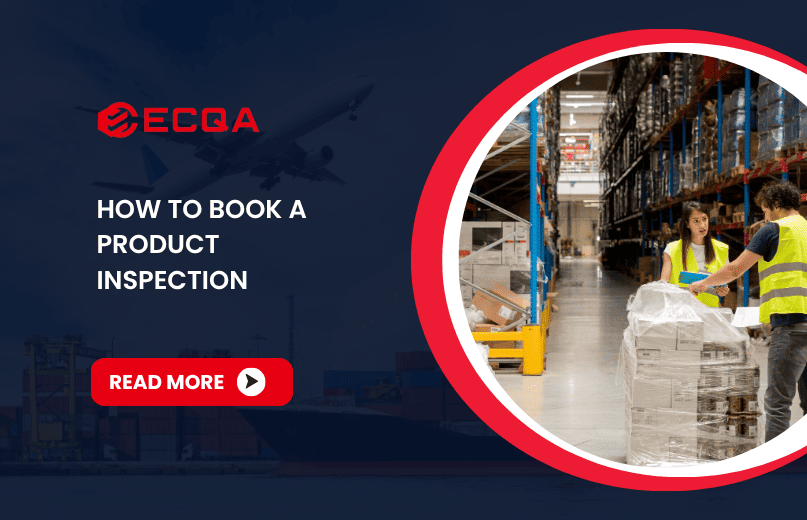
How to Book a Product Inspection:6 Steps
A product inspection is a structured quality control process designed to verify that manufactured goods meet agreed specifications before they are shipped. It protects buyers against costly defects, non-compliance issues, and reputational risks. Booking a professional inspection service ensures that every shipment is reviewed by trained inspectors who act as an independent set of eyes on the factory floor.

A product inspection provides factual evidence that the goods are safe, compliant, and ready for market. This guide explains how inspections work, why they are necessary, and the practical steps to book one with confidence.
What is a Product Inspection?
A product inspection is an independent verification conducted by a qualified inspector to evaluate whether finished goods comply with product specifications, safety standards, and customer requirements. The inspection typically covers:
- Appearance and workmanship – visible defects, scratches, color consistency
- Dimensions and functionality – size, measurements, and performance tests
- Labeling and packaging – barcodes, export markings, instructions, shipping cartons
- Safety and compliance – checks against regulatory or industry standards
Unlike production monitoring audits that occur during manufacturing, product inspections usually focus on the final stage before shipment. They provide a last safeguard to ensure that the buyer receives the exact product they ordered.
Why Buyers Should Book a Product Inspection
Booking a product inspection is a strategic component of quality assurance in today’s global supply chain. It provides measurable control, risk prevention, and supplier accountability through independent verification. The benefits include:
- Risk Reduction – Identifies defects before shipment, preventing costly rework or recalls.
- Regulatory Compliance – Confirms products meet international standards such as CE, RoHS, REACH, or FDA requirements.
- Supplier Accountability – Holds factories accountable for quality promises by providing independent verification.
- Customer Trust – Protects brand reputation by ensuring customers receive safe, reliable products.
According to industry studies, companies that adopt routine product inspections report up to a 30% reduction in defect rates and stronger supplier relationships. For importers, especially SMEs, this step is one of the most cost-effective investments in supply chain security.
Types of Product Inspections
Different inspection stages serve different purposes. Buyers should understand which type is appropriate before booking.
Pre-Production Inspection (PPI)
Conducted before mass production begins. Inspectors review raw materials, components, and factory preparation. This helps verify that suppliers have sourced the correct inputs and are ready to manufacture according to specifications.
Initial Production Inspection (IPI)
Performed at the start of production, typically when 10%–20% of goods are completed. The goal is to detect issues early before they affect the entire order. For example, in apparel manufacturing, an IPI might uncover incorrect fabric use or poor stitching.
During Production Inspection (DPI)
Carried out when 40%–60% of production is complete. DPI ensures continuous quality monitoring and allows corrective actions during the process. This is particularly useful for complex or high-value goods such as electronics.
Pre-Shipment Inspection (PSI)
The most common inspection type, conducted when 80% or more of goods are finished and packed. PSI checks quality, quantity, labeling, and packaging. It serves as the final verification before payment and shipment.
Container Loading Supervision (CLS)
Takes place during loading of goods into shipping containers. Inspectors verify that products are handled properly, cartons are not damaged, and the correct goods are being shipped. This reduces risks of damage and mix-ups in transit.
Step-by-Step: How to Book a Product Inspection
Booking a product inspection involves more than sending an email to a service provider. It requires planning, documentation, and clear instructions. The following steps outline the process:
Step 1: Define Your Inspection Requirements
Buyers should start by specifying:
- The product details (model numbers, SKUs, variations)
- The inspection standard (AQL level, defect classification)
- The timeframe (when production will reach the inspection stage)
- Any regulatory or customer-specific requirements
The clearer the instructions, the more effective the inspection will be.
Step 2: Select an Accredited Inspection Provider
Choose a reliable third-party provider with accreditation, industry expertise, and geographic coverage. Look for organizations with ISO 17020 or ISO 17025 recognition, and proven experience in your product category. Reputable providers assign inspectors fluent in local languages and familiar with factory conditions.
Step 3: Request a Quotation
Contact the inspection company with details of your order. Provide:
- Factory address and contact details
- Production schedule and completion status
- Quantity and SKUs involved
- Inspection type (PSI, DPI, etc.)
The provider will respond with pricing, usually based on a daily man-day rate plus travel costs. For detailed cost breakdowns and factors that affect pricing, refer to our guide on How Much Does a Product Inspection Cost
Step 4: Confirm Booking and Inspection Protocol
Once you accept the quotation, the provider will draft an inspection protocol outlining:
- Checklist of items to be inspected
- Sampling method (typically following ANSI/ASQ Z1.4 or ISO 2859 AQL standards)
- On-site tests to be performed
- Reporting format
Buyers should review and approve this protocol before the inspection date.
Step 5: Conduct the Inspection
On the agreed date, inspectors visit the factory, select samples, perform tests, and document findings. Inspections are typically accompanied by high-resolution photos, defect classification, and notes on compliance.
Step 6: Receive the Inspection Report
Within 24 hours, buyers usually receive a detailed report. This includes:
- Pass/fail summary
- Photos of samples and defects
- Packaging and labeling verification
- Inspector comments and recommendations
The report becomes a decision-making tool for whether to approve shipment, request rework, or hold payment.
A reliable supply chain depends on visible quality control. Product inspections offer that visibility by turning uncertainty into data and assumptions into verified results. Whether sourcing domestically or overseas, implementing a consistent inspection system is the most practical way to maintain standards and protect business credibility.
If your inspection report indicates nonconformities, please refer to our guide on Corrective Action After a Failed Inspection for practical steps to resolve issues efficiently.

 Request Free Sample Report
Request Free Sample Report